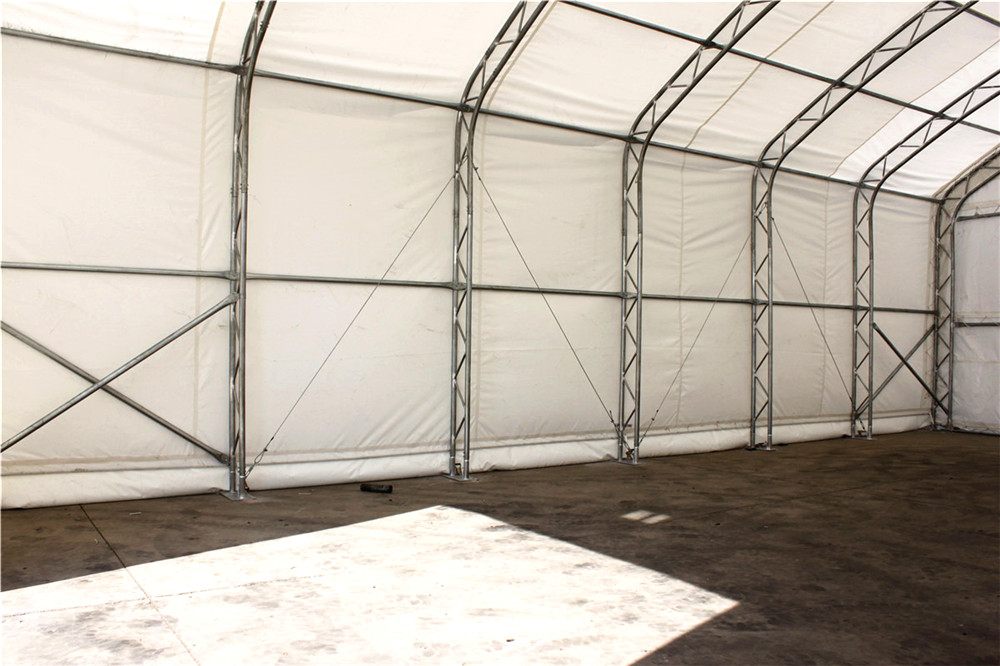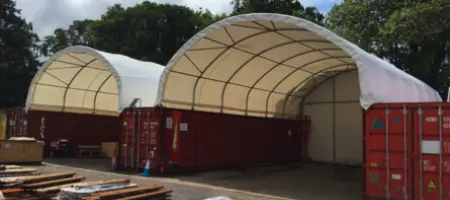In a world where construction costs and environmental concerns are rising, fabric structures are gaining attention as a cost-effective and sustainable alternative to traditional buildings. With their durability, adaptability, and efficiency, these buildings are revolutionizing storage and industrial applications.
One standout model leading this transformation is the TC334017T Series, a 10m wide double truss fabric building that exemplifies modern fabric-covered structures. But can coverall buildings truly replace conventional warehouses and storage facilities? Let’s explore.
Why Fabric Structures Are Gaining Popularity
Traditionally, fabric buildings were seen as temporary solutions, primarily used in military applications, event spaces, and agriculture. However, advances in engineering and materials have made them stronger, more durable, and more versatile than ever before.
A study from The National Institute of Building Sciences (NIBS) highlights how fabric structures reduce material consumption while maintaining high load-bearing capabilities, making them a sustainable choice for industrial and commercial use.
The Role of Fabric Structures in Sustainability
With global carbon emissions from construction reaching alarming levels, industries are looking for ways to minimize environmental impact. According to McKinsey & Company, cement and steel production contribute nearly 15% of global CO₂ emissions.
In contrast, fabric-covered buildings, like the TC334017T Series, require fewer raw materials, generate less waste, and offer longer life cycles. The 610g/m² PVC fabric used in this series is UV-resistant, fire-retardant, and has a 10-year lifespan, reducing the need for frequent replacements and repairs.
Additionally, a report by the American Institute of Architects (AIA) emphasizes the importance of modular and relocatable building solutions (source), noting that structures like fabric buildings help minimize construction waste while offering cost-efficient scalability.
How Coverall Buildings Improve Efficiency
Beyond sustainability, fabric buildings also offer unmatched speed and flexibility in installation and use.
For example:
✅ Faster Deployment – The TC334017T Series can be assembled in days rather than months, compared to traditional steel warehouses.
✅ Lower Costs – The double truss design provides high strength with less material, keeping costs lower while maintaining structural integrity.
✅ Relocatable – Need to move your warehouse? No problem. Unlike traditional buildings, fabric-covered structures can be dismantled and relocated with ease.
The US Department of Defense has even adopted fabric-based shelters for rapid deployment in emergency and military applications .
Real-World Applications: Where Fabric Buildings Make Sense
Fabric structures like the TC334017T Series are proving invaluable in various industries:
Industrial & Warehousing → Used for heavy equipment storage, manufacturing, and logistics hubs.
Agriculture & Farming → Protects livestock, grain, and farming equipment from harsh weather.
Energy & Mining → Deployed as temporary storage units at mining sites and oil fields.
Disaster Relief & Emergency Use → Utilized in humanitarian aid camps as fast, effective shelters.

The TC334017T Series: A Prime Example of Fabric Engineering
The TC334017T Series from Toughcover is an ideal coverall building for businesses needing versatile storage solutions. Its double truss arches (48 x1.5mm tubing) on 10ft spacing ensure exceptional load-bearing capacity, while additional steel wire tensioning and slanting support tubings reinforce stability.
Available Models:
TC334017T → 10 x 12.2 x 5.2 meters (33x40x17 feet)
TC335017T → 10 x 15.3 x 5.2 meters (33x50x17 feet)
TC336017T → 10 x 18.3 x 5.2 meters (33x60x17 feet)
TC337017T → 10 x 21.4 x 5.2 meters (33x70x17 feet)
With increasing demands for cost-effective, durable, and sustainable storage solutions, fabric-covered buildings like the TC334017T Series are becoming a dominant force in industrial and commercial sectors.
They’re already making an impact globally, from energy and agriculture to disaster relief and military applications. If fabric structures are trusted by NASA and the US military, they’re certainly strong enough for warehousing and industrial needs.
So, are fabric buildings the future of construction? While they won’t replace traditional structures entirely, their benefits in sustainability, affordability, and rapid deployment make them an indispensable part of modern storage solutions.





